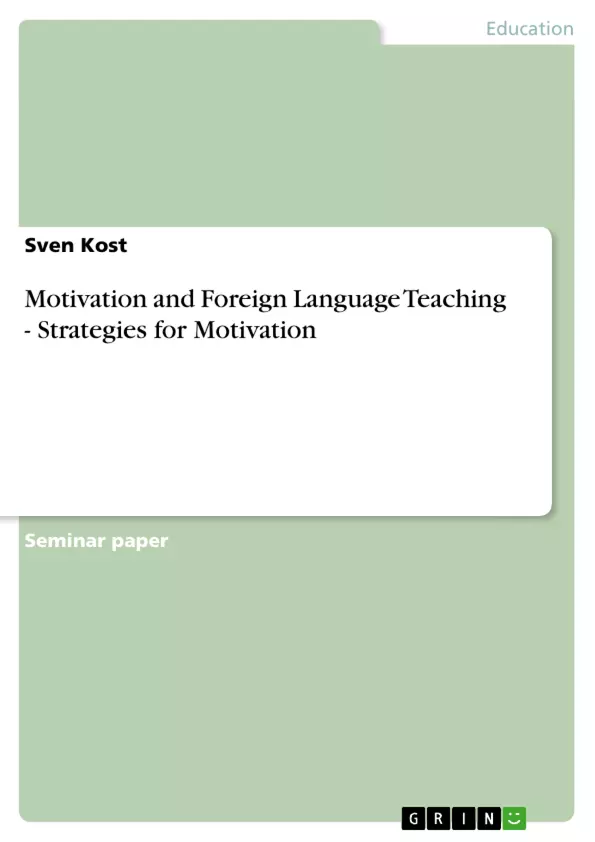The assumption that motivation and learning are directly connected to each other is supported by teachers, researchers and psychologists for a long period of time. They have pointed out that motivation can be regarded as the key issue in language learning processes, thus student motivation must be preserved, elaborated or even heightened. But how can this goal be reached by teachers or other instructors? In order to achieve this lofty mission, teachers and instructors have to make use of specific strategies for motivation. These strategies must be closely connected to the students’ lives and it has to be in the nature of these strategies to support the students in their learning process. Learning usually takes place in a classroom atmosphere, thus motivation has to be involved in this environment to guarantee learning effiency. This paper will give an overview about what different kinds of motivations are involved in the learning process and in second language learning in particular. Addionally it should give the reader an idea why motivation is so essential for learning processes. Further more it will take a critical look at what strategies for motivation teachers and other instructors can make use of in order to provide a successful learning environment. In the end it should be obvious how far the teacher can positively influence language learning processes, in particular second language acquisition processes.
Inhaltsverzeichnis (Table of Contents)
- Introduction
- Motivation
- Definition
- Intrinsic motivation
- Extrinsic motivation
- Integrative motivation
- Instrumental motivation
- What sort of motivation is good for L2 learning?
- Specific motivation strategies
- Purposes
- Advantages
- Student needs
- Teaching as the catalyst for learning
- Teacher as Artist
- Teacher as Technician
- Teacher as Role Model
- Creating interest
- Relevance of learning
- Feedback
- Motivation in the second language classroom
- Applying motivation strategies
Zielsetzung und Themenschwerpunkte (Objectives and Key Themes)
This paper aims to provide an overview of different types of motivation involved in the learning process, especially in second language acquisition. It examines the importance of motivation for learning and critically analyzes effective motivation strategies that teachers can use to create a successful learning environment. The paper explores how teachers can positively influence language learning processes, particularly second language acquisition.
- The significance of motivation in language learning
- Different types of motivation: intrinsic, extrinsic, integrative, and instrumental
- Strategies for fostering student motivation in the classroom
- The role of the teacher as a catalyst for learning
- The impact of motivation on learning efficiency and long-term retention
Zusammenfassung der Kapitel (Chapter Summaries)
- Introduction: The paper establishes the connection between motivation and learning, highlighting the crucial role of motivation in language learning processes. It outlines the need for teachers to employ specific strategies for motivation that are tailored to students' lives and support their learning journey.
- Motivation: This chapter defines motivation as an internal state that drives individuals to fulfill needs or desires. It distinguishes between intrinsic and extrinsic motivation, emphasizing the self-directed nature of intrinsic motivation and its long-term impact on learning. Extrinsic motivation, driven by external rewards or punishments, is presented as a less effective and potentially temporary solution for learning.
- Specific motivation strategies: This chapter delves into various strategies that teachers can utilize to motivate students. It discusses the purposes, advantages, and student needs that underpin these strategies. It also examines the role of the teacher as a catalyst for learning, exploring different teaching styles like the "artist," "technician," and "role model."
- Motivation in the second language classroom: This chapter focuses on the practical application of motivation strategies in the context of second language learning. It provides insights into how teachers can implement these strategies to enhance student engagement and learning outcomes.
Schlüsselwörter (Keywords)
The key focus of this paper is on motivation in the context of second language acquisition. It explores concepts like intrinsic and extrinsic motivation, integrative and instrumental motivation, as well as the role of teachers in creating a motivating learning environment. The paper also delves into strategies for fostering student motivation and their impact on learning efficiency and long-term retention.
- Quote paper
- Sven Kost (Author), 2003, Motivation and Foreign Language Teaching - Strategies for Motivation, Munich, GRIN Verlag, https://www.grin.com/document/45323



